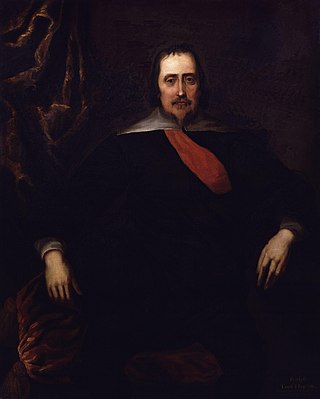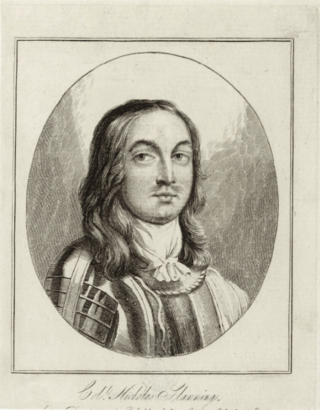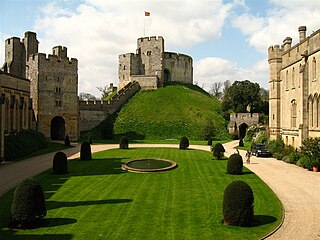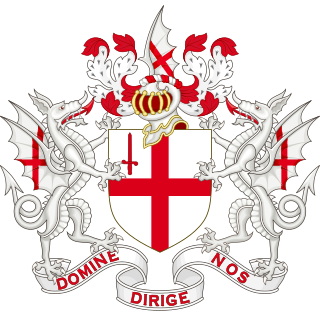Military career
Key locations mentioned in article
Browne was admitted as a member of the Honourable Artillery Company in 1622 and was an officer in the part-time London Trained Bands (LTBs). When the LTBs were expanded in April 1642, Browne was 1st Captain of the Orange Regiment. By mid-September, after the Civil War had broken out, he was organising a regiment of dragoons recruited in London, of which he became Colonel. He helped to disarm Royalists in Kent and then served under Sir William Waller at the seizure of Winchester in December. Browne's Dragoons were in action at Brill in January 1643. [1] [2] [3] [4] [5]
In July 1643, Browne was given an independent command, leading Mainwaring's Redcoats and the Green Auxiliaries of the LTBs with detachments of horse and dragoons to break up an assembly of Royalists at Sevenoaks in Kent. The Royalists retreated to Tonbridge where there was a three-hour skirmish on 24 July, when they were driven out of town and 200 were captured. [1] [6] It had become the practice for regiments drawn from the LTBs to serve for short periods with the Parliamentarian field armies. In December 1643 Parliament appointed Browne Sergeant-Major-General to command a City brigade consisting of the White and Yellow Regiments to reinforce Waller's army besieging Arundel Castle. The two regiments marched out on 4 and 5 January 1644 with a number of cannon, but heavy snow delayed their march for several days at Guildford, and they did not reach Petworth until 29 January, after Arundel had fallen. Here Browne fortified Petworth House in case Lord Hopton's Royalist army threatened. The brigade remained there for two months before moving to Midhurst on 20 March and then joining Waller's army on 27 March. Waller and Hopton manoeuvred and skirmished for two days, with Waller's army camped in the fields at Cheriton. Then on 29 March Waller sent skirmishers including some of Browne's men into Cheriton Wood on Hopton's left. Hopton drove them out, but his horse attacked without orders, precipitating a general engagement (the Battle of Cheriton). A cavalry battle took place in the space between the wings of foot, the London brigade having to drive back several Royalist probes in their direction. The Royalist cavalry lost heavily, and in the afternoon Browne led the foot back into Cheriton Wood as Hopton's army began to retreat. On 6 April Browne's City Brigade was engaged at Bishop's Waltham, where they forced the surrender of the fortified Bishop's Palace. The Londoners were now anxious to return home, and the two regiments left without orders, returning to the city as heroes on 14 April. Without the City Brigade Waller had to shut down operations. [1] [7] [8] [9] [10] [11] [12]
In June 1644 Parliament gave Browne a commission as Major-General for the counties of Oxfordshire, Buckinghamshire and Berkshire with the task of reducing the Royalist garrisons, and assigned him a brigade consisting of the Red, White and Blue Auxiliaries of the LTBs, all understrength. It was learnt that the King's army from Oxford was moving eastwards and threatening the Parliamentarian Eastern Association, so Browne was directed into Hertfordshire to protect these counties. He was joined by the Essex and Hertfordshire Trained Bands. By the time his force assembled at Barnet, he was too late to help Waller, who was defeated by the Royalists at the Battle of Cropredy Bridge on 29 June. When he joined Waller at Towcester on 2 July, Waller's dispirited London brigade assumed that Browne's had been sent to relieve them, and they set up a chant of 'Home, Home!' The Essex and Hertfordshire men were also deserting, and on 6 July they wounded Browne in the face when he confronted them. [1] [13] [14] [15] [16] [17]
The Royalist army having disengaged and moved west, Browne was sent to capture Greenland House near Henley-on-Thames, under his original orders, and then moved to Reading. Ordered to join Waller at Abingdon-on-Thames, he objected that he had only 'three broken regiments of London auxiliaries, not above 800 in all' to hold Reading. In fact, he had fallen out with Waller and threatened to resign if forced to accept the latter's orders. In the end Waller left for London and Browne was put in command of the whole force at Abingdon, marching in with his brigade on 15 August. He and his troops were not involved in the Second Battle of Newbury in October, but as Governor of Abingdon, Browne kept up active skirmishing against the Royalist stronghold of Oxford during the winter. In the summer of 1645 he participated in the Second Siege of Oxford, and in September had to put down a serious clash between the garrison of Aylesbury and other Parliamentarian troops. He was again active in the final Third Siege of Oxford in 1646 and continued as Governor of Abingdon until the end of the First Civil War later that year. [1] [18] [19]

The Battle of Roundway Down was fought on 13 July 1643 near Devizes, in Wiltshire during the First English Civil War. Despite being outnumbered and exhausted after riding overnight from Oxford, a Royalist cavalry force under Lord Wilmot won a crushing victory over the Parliamentarian Army of the West under Sir William Waller.

Sir Arthur Haselrig, 2nd Baronet was a leader of the Parliamentary opposition to Charles I and one of the Five Members whose attempted arrest sparked the 1642–1646 First English Civil War. He held various military and political posts during the 1639–1651 Wars of the Three Kingdoms but became an opponent of Oliver Cromwell during the Protectorate. In 1660, his actions inadvertently helped restore Charles II to the throne; unlike many senior Parliamentary leaders, his life was spared but he was confined to the Tower of London, where he died on 7 January 1661.

Sir William Waller JP was an English soldier and politician, who commanded Parliamentarian armies during the First English Civil War. Elected MP for Andover to the Long Parliament in 1640, Waller relinquished his military positions under the Self-denying Ordinance in 1645. Although deeply religious and a devout Puritan, he belonged to the moderate Presbyterian faction, who opposed the involvement of the New Model Army in politics post 1646. As a result, he was one of the Eleven Members excluded by the army in July 1647, then again by Pride's Purge in December 1648 for refusing to support the Trial of Charles I, and his subsequent execution in January 1649.

Ralph Hopton, 1st Baron Hopton was an English politician, military officer and peer. During the First English Civil War, he served as Royalist commander in the West Country, and was made Baron Hopton of Stratton in 1643.

Sir Michael Livesey, 1st Baronet, also spelt Livesay, was a Puritan activist and Member of Parliament who served in the Parliamentarian army during the Wars of the Three Kingdoms. He was one of the regicides who approved the Execution of Charles I in January 1649.

The Battle of Cheriton of 29 March 1644 was an important Parliamentarian victory during the First English Civil War. Sir William Waller's "Army of the Southern Association" defeated a Royalist force jointly commanded by the Earl of Forth and Sir Ralph Hopton. Defeat ended Royalist hopes of retaking South East England and forced them onto the defensive for the rest of 1644.

Sir Nicholas Slanning was a soldier and landowner from Devon who sat in the House of Commons from 1640 to 1642. He served in the Royalist army during the First English Civil War and was mortally wounded at Bristol on 26 July 1643.

The battle of Sourton Down was a successful Parliamentarian ambush at Sourton Down, in South West England, on 25 April 1643, during the First English Civil War. After a failed attack on Royalist-held Launceston, the Parliamentarians fell back to their base at Okehampton, pursued by a Royalist army under Sir Ralph Hopton, who marched overnight, planning to attack the town at dawn.
1644 was the third year of the First English Civil War. The King's position continued to decline and the Long Parliament sent the Propositions of Uxbridge, an attempt to end the war, to the king at Oxford

William Ogle, 1st Viscount Ogle was an English soldier from Northumberland who settled in Hampshire and was Member of Parliament for Winchester from 1640 to 1643. He served in a number of wars and was Royalist governor of Winchester from 1643 to 1645.
John Bingham (1613–1673) was an English politician who sat in the House of Commons between 1645 and 1659. He served in the Parliamentary army in the English Civil War.
Sir William Godolphin was an English soldier and politician who sat in the House of Commons in 1640. He fought for the Royalist cause in the English Civil War.

Sir Humphrey Bennet (1605–1667) was a Hampshire landowner who fought for the Royalists in the First English Civil War, in which he rose to the command of a cavalry brigade. He went into exile in 1645, returned home in 1646 and was active in a number of Royalist conspiracies during The Protectorate.

The siege of Arundel took place during the First English Civil War, from 19 December 1643 to 6 January 1644, when a Royalist garrison surrendered to a Parliamentarian army under Sir William Waller.
The London Militia were the part-time military forces in the City of London. From their formal organisation as the London Trained Bands in 1559 they were periodically embodied for home defence, for example in the army mustered at Tilbury during the Armada Campaign of 1588. They saw a great deal of active service during the English Civil War, including the First and Second Battles of Newbury and the battles of Cheriton and Cropredy Bridge. Throughout their history they were used to suppress civil disorder and insurrection around the capital. In 1794 the London Trained Bands were reconstituted as part of the national Militia, and in 1881 the Royal London Militia became a battalion of the Royal Fusiliers. Although intended to be a reserve unit, the battalion saw considerable action on the Western Front during World War I. After 1921 the militia had only a shadowy existence until its final abolition in 1953.

The London Trained Bands (LTBs) were a part-time military force in the City of London from 1559 until they were reconstituted as conventional Militia regiments in 1794. They were periodically embodied for home defence, for example in the army mustered at Tilbury during the Armada Campaign of 1588. They saw a great deal of active service during the English Civil War, including the First and Second Battles of Newbury, and the battles of Alton, Cheriton, Cropredy Bridge and Lostwithiel. Throughout their history they were used to suppress civil disorder and insurrection around the capital.
The Kent Trained Bands were a part-time militia recruited from Kent in South East England, first organised in 1558. They were periodically embodied for home defence and internal security, including the Spanish Armada campaign in 1588, and saw active service during the Wars of the Three Kingdoms. They fell into abeyance in the early 18th century.
The Middlesex Militia was an auxiliary military force in the county of Middlesex in South East England. From their formal organisation as Trained Bands, in 1572 and their service during the Armada Crisis and in the English Civil War, the Militia regiments of Middlesex served during times of international tension and all of Britain's major wars. By 1853 there were five regiments in the county. They provided internal security and home defence but sometimes operated further afield, including France and the Mediterranean, relieving regular troops from routine garrison duties, and acting as a source of trained officers and men for the Regular Army. Some of the infantry battalions went on active service during the Second Boer War and all served as Special Reserve training units in World War I. After 1921 the militia had only a shadowy existence until its final abolition in 1953.
The Westminster Trained Bands were a part-time military force established in 1572, recruited from residents of the City of Westminster. As part of the larger London Trained Bands, they were periodically embodied for home defence, such as during the 1588 Spanish Armada campaign. Although service was technically restricted to London, the Trained Bands formed a major portion of the Parliamentarian army in the early years of the First English Civil War. After the New Model Army was established in April 1645, they returned to their primary function of providing security for the palaces of Westminster and Whitehall. Following the 1660 Stuart Restoration, the City of London Militia Act 1662 brought them under the direct control of the Crown, with the Trained Bands becoming part of the British Army.













